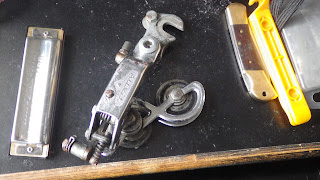Sunday, April 3, 2016
The best derailleur ever made
The Huret Allvit? Really? Now hear me out. I know it has a bad reputation, but I'm not convinced that reputation is deserved. While the execution is not perfect, the design is positively inspired and it has a number of other design elements which, to me at least, scream "QUALITY". The problem with these design elements, and I will get into this, is that they are not idiot-proof. Consider:
1. The parallelogram design moves the top pulley further out as you move to larger sprockets in a design that predates the patented Suntour slant parallelogram by several years (1958 vs. 1964). Moreover, this motion is nonlinear--the motion is faster as the pulley cage is moved inwards, similar to how there is a bigger difference in teeth as the sprockets get larger.
2. The jockey pulleys have no teeth and fully adjustable ball bearings. Since the pulleys transmit no torque, there is no need for teeth. Both features will reduce drivetrain friction.
3. Every single pivot except for the cable hanger (which is riveted on) has a fully adjustable bearing with a locknut. Compare this with modern derailleurs which are almost always riveted together. Once the pivots wear out, the unit is done: you have to throw it away. With the Allvit, if the shifting becomes less precise because the pivots are loose, you just pull the thing off, disassemble it, clean up each part, and put it back together with the pivots nice and tight. This is almost certainly the source of the bad reputation these derailleurs had: if just one of these pivots is out of adjustment then it won't work well, if at all.
It was not all good, of course. The cable clamp was particularly poor and in conjunction with the strong parallelogram return spring and the thin gauge shifter cables of the time produced a lot of broken cables.
Towards the end of its life, the Allvit was being used on a lot of cheap, department store "ten-speed" and utility bikes. In order for it to work well, it needs to be maintained, something that's not going to happen with these cheaper bikes. The Japanese derailleurs, by contrast, are more idiot proof. They always work, no matter who attached them to the bike or how badly. They also tend to be more aesthetically pleasing. Note how on this vintage Shimano 600 derailleur the adjustment screws are placed neatly beside each other alongside the top parallelogram plate:
Contrast the more industrial look of the Allvit with one adjustment screw on the fixed top plate and the other down below jutting out of the bottom parallelogram arm.
Subscribe to:
Posts (Atom)

